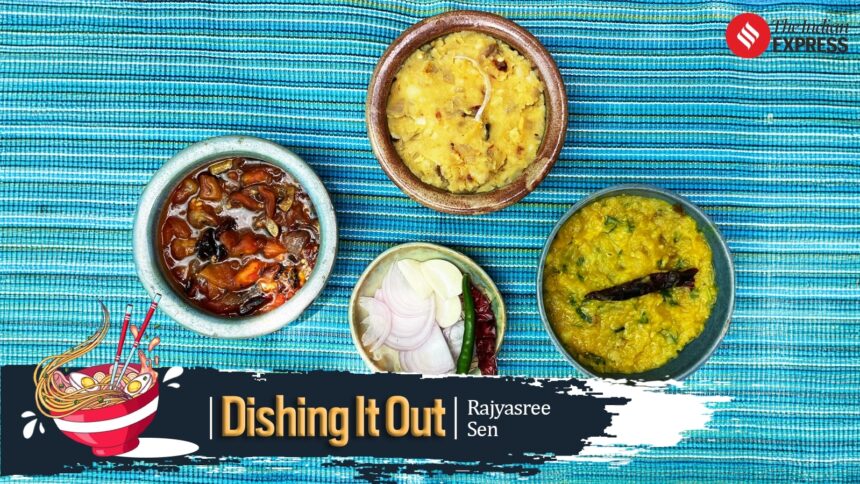Many moons ago, I remember watching a Nigella Lawson show where she said she would make a fish finger bhorta. My ears perked up, because bhorta – not to be mistaken with bharta – is a uniquely East Bengal preparation. It’s a simple, dry mash of vegetables (sometimes just their peels), occasionally with fish or shrimp, mixed with mustard oil, raw onions, fresh coriander, and dried red chillies roasted in mustard oil. Think of the texture as that of mashed potatoes, and it is eaten with rice.
Lawson’s version (I understand fish fingers were added for their ubiquity in England) was surprisingly close to the real thing. She learnt it from a journalist’s X feed and her version, too, had onions cooked till translucent, mashed with , some mustard oil and crispy fried fish fingers mashed into the pan with some coriander, spinach and lime.
Bhorta is popular in Bangladesh. While bharta, especially baingan ka bharta – made of cooked and mashed brinjals – is popular across Indian cuisines, the Bengali Muslim or Baangal bhorta repertoire is more expansive. The base remains the same: mashed vegetables, fish or prawns paired with mustard oil, garlic, onions and dried red chillies. But never ginger.
The most common bhortas include brinjal, potato (Bengal’s favourite vegetable), vegetable peels, prawns, hilsa, and other fresh or dried fish. It’s quick, tasty, needs minimal prep, and very few utensils. It’s also a vegetarian’s dream, just switch out the fish for a range of vegetables or peels.
At home, we never really made bhorta. Alu maakha – a version of bhorta made with mashed potatoes with mustard oil and green chillies – yes, but nothing else. Panta bhaat, a dish of rice soaked overnight in water and eaten with fried vegetables, was also rare, made occasionally for a Punjabi school friend of mine. My grandfather, from West Bengal, considered these peasant foods – meals for those without easy access to meat or high-quality fish. I used to think this was snobbery. But bhorta is, at its heart, simple peasant food from rural Bengal.
Bhorta finds mention in the folklore of undivided Bengal as early as the 8th century, with references to jute-leaf mash. In the 17th century, Portuguese missionary Friar Sebastian Manrique recorded that the common people in Bengal ate panta bhaat, salt, shak (spinach), and mashed vegetables. The elite, meanwhile, indulged in ghee, butter, milk, chhana, and lots of mishti.
As I’ve grown older and started cooking and experimenting, I find bhorta preparations incredibly delicious and easy to prepare. The ingredients, like I mentioned earlier, are basic. You can steam, grill, or roast your core ingredient, and then mash it all together with your hand or a fork. While bhorta is believed to have originated with Bengali Muslims, it’s now central to Baangal cuisine.
I got so distracted by a recipe I found while researching this piece that I made a bhorta for lunch. I also came across another recipe that shows the versatility and inclusiveness of bhorta, ensuring nothing goes to waste in the kitchen – coriander bhorta. This is a mash of fresh coriander leaves, fresh green chillies instead of dried red ones, a few spices, sautéed in mustard oil and mashed together.
Where I differ from most recipes is that I rarely use raw onions. Instead, I roast sliced onions with dried red chillies until slightly brown. This sweetens the onions, takes away the pungency, and acts as a good foil to the spice of the red chillies. You can make bhorta with pumpkin, potato peel, lauki peel, bhindi or okra, roasted tomatoes, banana blossoms, and spinach. Bhorta is even made with kathal or jackfruit seeds – these are dried, boiled and then mashed. Baangals would make them with shutki (dried or fermented fish). They can even be made with a spice as the main ingredient. I’ve had one with nigella seeds or kalo jeera, another with mustard seeds, and another with poppyseeds or posto. You’d add these to a larger meal as the flavour can be quite strong.
Village-made bhortas are another level altogether. The ingredients are fresher, and they’re mashed by hand using a sheel nora – a stone slab and roller that grinds ingredients slowly, releasing oils and flavour in a way no food processor can match.
Today, bhorta has all but become Bangladesh’s national dish. An entire meal of different bhortas is not uncommon, and not at all boring.
Here’s my version of masoor dal bhorta. Try it. Taste the food of my people, or at least, some of them.
Masoor Daal – 1 cup
Onions – ½ an onion, sliced fine
Garlic – 2 cloves, sliced fine
Turmeric powder – ½ tsp
Salt – 1 tsp (to taste)
Coriander Leaves – 2 tablespoons, chopped
Mustard Oil – 2-3 tbsp
Dry Red Chilli – 2 to 4








